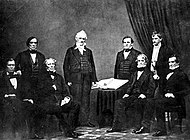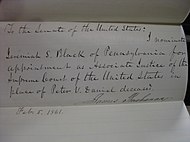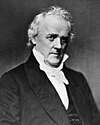| Jeremiah Black | |
|---|---|
 Portrait c. 1870-1880 Portrait c. 1870-1880 | |
| 6th United States Supreme Court Reporter | |
| In office 1861–1862 | |
| Preceded by | Benjamin Howard |
| Succeeded by | John Wallace |
| 23rd United States Secretary of State | |
| In office December 17, 1860 – March 5, 1861 | |
| President | James Buchanan Abraham Lincoln |
| Preceded by | Lewis Cass |
| Succeeded by | William Seward |
| 24th United States Attorney General | |
| In office March 6, 1857 – December 16, 1860 | |
| President | James Buchanan |
| Preceded by | Caleb Cushing |
| Succeeded by | Edwin Stanton |
| Personal details | |
| Born | Jeremiah Sullivan Black (1810-01-10)January 10, 1810 Stony Creek, Pennsylvania, U.S. (new Glades) |
| Died | August 19, 1883(1883-08-19) (aged 73) York, Pennsylvania, U.S. |
| Political party | Democratic |
| Spouse | Mary Forward (1836–1883) |
| Children | 4, including Chauncey |
| Signature | |
Jeremiah Sullivan Black (January 10, 1810 – August 19, 1883) was an American statesman and lawyer. He served as a justice on the Supreme Court of Pennsylvania (1851–1857) and as the Court's Chief Justice (1851–1854). He also served in the Cabinet of President James Buchanan, first as Attorney General (1857–1860), and then Secretary of State (1860–1861).
Early life
Jeremiah S. Black was born on January 10, 1810, in Stony Creek, Pennsylvania, near Dauphin, Pennsylvania. He was the son of Representative Henry Black and Mary (Sullivan) Black. Jeremiah Black was largely self-educated before beginning to study law with Chauncey Forward. He was admitted to the Pennsylvania bar before he was 21. He gradually became one of the leading American lawyers, and was a member of the Pennsylvania Supreme Court (1851–1857), serving as Chief Justice (1851–1854).
James Buchanan's Cabinet (1857–1861)


In 1857, he joined the administration of James Buchanan as the Attorney General. In this capacity, he successfully contested the validity of the California land claims to about 19,000 square miles (49,000 km) of land, fraudulently alleged to have been granted to land-grabbers and others by the Mexican government prior to the close of the Mexican–American War.
When Secretary of State Lewis Cass resigned in December 1860, Black was appointed to replace him, serving from December 17, 1860, to the end of Buchanan's term on March 4, 1861. Black successfully urged the appointment of Edwin M. Stanton as his successor as Attorney General.
Black was perhaps the most influential of President Buchanan's official advisers too, during the secession crisis. He denied the constitutionality of secession, and urged that Fort Sumter be properly reinforced and defended. However, he argued that a state could not be legally coerced by the Federal government.
On February 5, 1861, President Buchanan nominated him for a seat on the Supreme Court of the United States; but a February 21 motion to proceed to consider the nomination was defeated 25–26, and it lapsed at the end of the 36th Congress. Subsequently, Black was named Reporter of Decisions of the Supreme Court of the United States, a position he held for two years. After publishing the reports for 1861 and 1862 (U.S. 66–67), he resigned and devoted himself almost exclusively to his private law practice.
Later life
After the Civil War, he vigorously opposed the Congressional plan for Reconstruction and drafted President Andrew Johnson's message vetoing the Reconstruction Act passed on March 2, 1867; the veto was overridden. Black was also briefly part of the president's defense team at the outset of his 1868 impeachment trial before the United States Senate.
From 1866 to 1868, Black sought U.S. recognition of his clients' Guano Islands Act claim on Alto Velo Island, which was disputed by the Dominican Republic.
Later, from 1869 to 1876, Black served with Montgomery Blair and Matthew H. Carpenter as Counsel for U.S. Secretary of War William W. Belknap, who in 1876 was impeached on a charge of corruption. Black also represented Samuel J. Tilden during the contest for the presidency between Tilden and Rutherford B. Hayes. He died on August 19, 1883, at the age of 73, and was buried at Prospect Hill Cemetery in York, Pennsylvania.
Family
On March 23, 1836, Black married the former Mary Forward. They had four children, Rebekah Black, Chauncey Black, Henry Black, Jr., and Mary Sullivan Black.
References
- Vile, John R. (2001). Great American Lawyers. ABC-CLIO. p. 59. ISBN 9781576072028. Retrieved May 25, 2020.
- ^ Chisholm 1911.
- McMillion, Barry J.; Rutkus, Denis Steven (July 6, 2018). "Supreme Court Nominations, 1789 to 2017: Actions by the Senate, the Judiciary Committee, and the President" (PDF). Washington, D.C.: Congressional Research Service. Retrieved August 27, 2018.
- Seward, William Henry (1868). Alto Velo Island. Report of the Secretary of State on the Claim of Patterson and Murguiendo [sic] with a Further Argument of the Claimants. Washington, D.C.: U.S. Government Printing Office.
- Poore, Ben. Perley, Perley's Reminiscences of Sixty Years in the National Metropolis, Vol.2, pp.310-311 (1886).
Attribution:
 This article incorporates text from a publication now in the public domain: Chisholm, Hugh, ed. (1911). "Black, Jeremiah Sullivan". Encyclopædia Britannica. Vol. 4 (11th ed.). Cambridge University Press. p. 18.
This article incorporates text from a publication now in the public domain: Chisholm, Hugh, ed. (1911). "Black, Jeremiah Sullivan". Encyclopædia Britannica. Vol. 4 (11th ed.). Cambridge University Press. p. 18.
Further reading
- Brigance, William Norwood. Jeremiah Sullivan Black: a defender of the Constitution and the Ten commandments (University of Pennsylvania Press, 2017) online.
- Buchanan, John G. "JEREMIAH S. BLACK—THE ADVOCATE." Pennsylvania History: A Journal of Mid-Atlantic Studies 14.1 (1947): 35-40. online
- Thorpe, Francis Newton. "Jeremiah S. Black." Pennsylvania Magazine of History and Biography 50.2 (1926): 117-133. online
Primary sources
- Black, C. F., Essays and Speeches of Jeremiah S. Black, with a Biographical Sketch, New York: 1885. online
- Clayton, Mary Black. Reminiscences of Jeremiah Sullivan Black (1887) online.
External links
| Legal offices | ||
|---|---|---|
| Preceded byJohn Bannister Gibson | Chief Justice of the Pennsylvania Supreme Court 1851–1854 |
Succeeded byEllis Lewis |
| Preceded by | Associate Justice of the Pennsylvania Supreme Court 1854–1857 |
Succeeded byJames Armstrong |
| Preceded byCaleb Cushing | United States Attorney General 1857–1860 |
Succeeded byEdwin Stanton |
| Preceded byBenjamin Howard | United States Supreme Court Reporter of Decisions 1861–1862 |
Succeeded byJohn Wallace |
| Political offices | ||
| Preceded byLewis Cass | United States Secretary of State 1860–1861 |
Succeeded byWilliam Seward |
| Cabinet of President James Buchanan (1857–1861) | ||
|---|---|---|
| Secretary of State |
|  |
| Secretary of the Treasury |
| |
| Secretary of War |
| |
| Attorney General |
| |
| Postmaster General |
| |
| Secretary of the Navy |
| |
| Secretary of the Interior |
| |
| Chief justices of Pennsylvania | ||
|---|---|---|
| 18th century |  | |
| 19th century | ||
| 20th century |
| |
| 21st century | ||
| Taney Court (1836–1864) | |||||||||||||||
|---|---|---|---|---|---|---|---|---|---|---|---|---|---|---|---|
| Justices |  | ||||||||||||||
| Decisions |
| ||||||||||||||
| Statutes | |||||||||||||||
| (← 1868) 1872 United States presidential election (1876 →) | |||||||||
|---|---|---|---|---|---|---|---|---|---|
| Republican Party (Convention) |
| ||||||||
| Liberal Republican Party ▌Democratic Party (Convention) |
| ||||||||
| |||||||||
- 1810 births
- 1883 deaths
- 19th-century Pennsylvania politicians
- Buchanan administration cabinet members
- Members of the defense counsel for the impeachment trial of Andrew Johnson
- Pennsylvania lawyers
- People from Dauphin County, Pennsylvania
- Pennsylvania Democrats
- Reporters of Decisions of the Supreme Court of the United States
- Justices of the Supreme Court of Pennsylvania
- Union (American Civil War) political leaders
- Attorneys general of the United States
- United States secretaries of state
- Unsuccessful nominees to the United States Supreme Court
- 19th-century American judges

